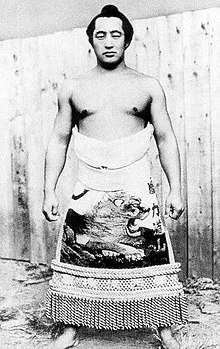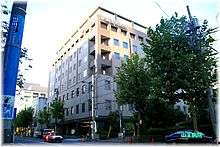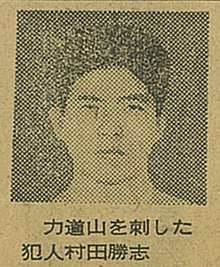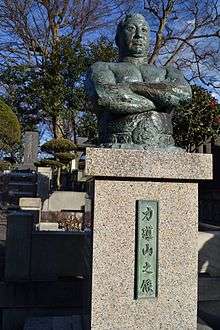Rikidōzan
Mitsuhiro Momota (Japanese: 百田 光浩) (born Kim Sin-rak; Korean: 김신락; November 14, 1924[1] – December 15, 1963), better known as Rikidōzan (力道山), was a Korean Japanese professional wrestler known as The Father of Puroresu and one of the most influential men in professional wrestling history. Initially, he had moved from his native country Korea to Japan to become a sumo wrestler. He was credited with bringing the sport of professional wrestling to Japan at a time when the Japanese needed a local hero to emulate and was lauded as a national hero. He was inducted into the WWE Hall of Fame in 2017, becoming the first Korean inductee and the third puroresu star to be inducted after Antonio Inoki and Tatsumi Fujinami. He was murdered by a member of the Yakuza in 1963.
| Rikidōzan | |
|---|---|
 | |
| Birth name | Kim Sin-rak (김신락) |
| Born | November 14, 1924 Hongwon County, Kankyō-nan Prefecture, Japanese Korea |
| Died | December 15, 1963 (aged 39) Minato, Tokyo, Japan |
| Cause of death | Murder |
| Professional wrestling career | |
| Ring name(s) | Rikidōzan Mitsuhiro Momota |
| Billed height | 1.75 m (5 ft 9 in) |
| Billed weight | 110 kg (243 lb) |
| Billed from | Nagasaki |
| Trained by | Harold Sakata Bobby Bruns |
| Debut | October 28, 1951 |
| Rikidōzan Mitsuhiro | |
|---|---|
| 力道山 光浩 | |
| Personal information | |
| Height | 1.75 m (5 ft 9 in) |
| Weight | 116 kg (256 lb; 18 st 4 lb) |
| Career | |
| Stable | Nishonoseki |
| Record | 135–82–15 |
| Debut | May 1940 |
| Highest rank | Sekiwake (May 1949) |
| Retired | September 1950 |
| Championships | 1 (Makushita) 1 (Sandanme) |
| Special Prizes | Outstanding Performance (1) |
| Gold Stars | 2 (Azumafuji) |
| * Up to date as of May 2013. | |
Biography
Early years

Rikidōzan was born Kim Sin-rak in Kankyō-nan Prefecture, Japanese Korea, on November 14, 1924.
He was the youngest son of Kim Soktee, the owner of a Korean farm with a Confucian tradition, and his wife Chon Gi. When his father fell ill, Sin-rak tended to him, while his mother and older brothers tended to the farm. His father died in 1939.[2][3][4]
He became the adopted son of the farmer "Momota family" of Nagasaki Prefecture when he was young and trained to be a sumo wrestler. He joined Nishonoseki stable, and made his debut in May 1940. Disguising his Korean ethnicity, Sin-rak claimed that his name was Mitsuhiro Momota (Momota being the surname of the family which adopted, but later disowned him) and listed his birthplace as Omura, Nagasaki. He was given the shikona of Rikidōzan. He reached the top makuuchi division in 1946 and was runner-up to yokozuna Haguroyama in the tournament of June 1947, losing a playoff for the championship. He fought in 23 tournaments in total, with a win-loss record of 135–82. His highest rank was sekiwake.[5]
Professional wrestling
Rikidōzan gave up sumo in 1950. Although he claimed it was for financial reasons, discrimination against Koreans may have been a contributory factor.[6] He made his professional wrestling debut in 1951 with a ten-minute draw against Bobby Bruns. He established himself as Japan's biggest wrestling star by defeating one American wrestler after another. This was shortly after World War II, and the Japanese needed someone who could stand up to the Americans. Rikidōzan thus became immensely popular in Japan. His American opponents assisted him by portraying themselves as villains who cheated in their matches. Rikidōzan himself was booked as a villain when he wrestled in America early on but went on to become one of the first Japanese wrestlers to be cheered as a baby face in post World War II America.
Rikidōzan gained worldwide renown when he defeated Lou Thesz for the NWA International Heavyweight Championship on August 27, 1958 in Japan. In another match, Thesz willingly agreed to put over Rikidōzan at the expense of his own reputation. This built up mutual respect between the two wrestlers, and Rikidōzan never forgot what Thesz did. He would go on to capture several NWA titles in matches both in Japan and overseas. Rikidōzan also trained professional wrestling students, including soon-to-be wrestling legends Kanji "Antonio" Inoki, Ooki Kintaro, and Shohei "Giant" Baba.
His signature move was the karate chop, which was actually based on sumo's harite, rather than actual karate. It is rumoured that he had been coached by fellow Korean Masutatsu Oyama, but he is more likely to have been coached by another Korean karateka, Nakamura Hideo.
With his success in pro wrestling, Rikidōzan began acquiring properties such as nightclubs, hotels, condominiums and boxing promotions. He established the Japan Pro Wrestling Alliance (JWA), Japan's first professional wrestling promotion, in 1953. His first major feud was against Masahiko Kimura, the famous judoka who had been invited by Rikidōzan to compete as a professional wrestler. Other famous feuds included those against Thesz in 1957–58, against Freddie Blassie in 1962, and against The Destroyer in 1963. In wrestling journalist John M. Molinaro's 2002 book Top 100 Pro Wrestlers of All Time, it is noted that two of Rikidōzan's matches are rated in the top ten television programs of all time in Japan.[7] His October 6, 1957 sixty-minute draw with Lou Thesz for the NWA World Heavyweight Championship drew an 87.0 rating, and his May 24, 1963 sixty-minute two out of three falls draw with The Destroyer drew a 67.0 rating, but a larger viewing audience (the largest in Japanese history) than the previous match, since more people had television sets by 1963.
Personal life
Aside from pro wrestling, Rikidōzan was a businessman and began acquiring properties such as nightclubs, hotels, condominiums and boxing gyms. Rikidōzan’s luxurious apartment, known as Riki Mansion, is located in Akasaka, Tokyo and is recognisable for the large "R" printed on the side of the building. Rikidōzan also owned a 9-storey "Riki Sports Palace" in Shibuya, Tokyo, which included a bowling alley, a pool room, a bar known as "Club Riki", and a restaurant known as "Riki Restaurant". Shortly before his death, Rikidōzan had purchased land in Lake Sagami and had begun work on a large scale golf course to be known as "Lakeside Country Club", set to feature facilities such as a shooting range, indoor skate rink, hotel, and more along the shore of Sagami Lake. However, it remained incomplete due to his death and was eventually sold and became Sagami Lake Resort, a hotel.
Rikidōzan was known to have many girlfriends throughout his lifetime and was often known to see numerous women at the same time. He married his wife, Keiko Tanaka shortly before his death. A 1984 article in weekly Playboy drew much attention after it revealed Rikidōzan was actually from Korea and had been married and had children before he met Tanaka, considered to be taboo in Japan.[8]
After his wrestling matches, he would often immediately go to Riki Sports Palace and start drinking without cleaning up any wounds. He was known to joke with bar staff and say "work was awful today" while either being covered in blood or having a large scar on his face.[8]
Rikidōzan spent his spare time hunting and was said to own several legitimate hunting guns at the time of his death. His autobiography also claimed that Rikidozan made his wife carry a handgun wherever she went. He would also play shogi with professional player Kusama Matsuji.[8]
After Rikidōzan's death, actor Ikuro Otsuji also lived in Riki Mansion in his later years.
After his death, his son, Mitsuo Momota said that while Rikidōzan owned a lot of property and real estate, he also had a lot of debt, and the inheritance tax on his estate was upwards of ¥20,000,000 ($180,000) due to Rikidōzan owing millions of yen in unpaid taxes.[9]
Due to the notoriety he gained from his wrestling career, Rikidōzan was a huge celebrity in Japan and was frequently discussed in tabloids and magazines. Despite his image of a national hero, he had a reputation for being a troublemaker, especially in the later years of his career. Due to his deteriorating physical health, Rikidōzan began to abuse painkillers in the early 1960s and would take stimulants before and after his matches.
When Rikidōzan was in a good mood, he would leave bar staff a tip of as much as ¥10,000, but when he was in a bad mood, bar fights and violence were an almost daily event.[10][11] Rikidōzan's reputation for being a heavy drinker also aroused suspicion surrounding the legitimacy of pro wrestling, as he would "fight" opponents and then be seen drinking and socialising with them just hours later.[12] At one point, Rikidōzan was in a bar with Roberto Barbon, a Cuban baseball player for the Hankyu Braves, who had been drinking and started heckling Rikidōzan, calling professional wrestling fake. Rikidōzan became hostile, threatening violence and demanding an apology, which Barbon agreed to.
Death


On December 8, 1963, Rikidōzan was stabbed once by Katsushi Murata, a member of the ninkyō dantai Sumiyoshi-ikka, a sub branch of the yakuza, after an altercation in a nightclub. Rikidōzan alleged that Murata stepped on his shoe, and demanded an apology. Murata refused and the two began to argue which eventually led to Rikidōzan punching Murata in the face, knocking him against a wall. Rikidōzan then mounted Murata and continued to punch him on the ground until Murata stabbed Rikidōzan once in the abdomen. Both immediately fled the scene and Rikidōzan was taken to Sannoh Hospital, where a doctor decreed the wound to be non-serious but advised Rikidōzan to have surgery. The surgery was successful and he returned home, but went against doctors orders and began eating and drinking the same day, sending his assistant to the store for sushi and sake. Due to drinking so much, Rikidōzan worsened his condition and required a second surgery one week later, but had developed peritonitis and died at approximately 9:50pm on December 15, 1963. He was 39 years old.[13][14][15]
Rikidōzan's funeral was held on December 20, 1963, in Ikegami Honmonji Temple in Ōta, Tokyo.[16][17] Among those in attendance were Rikidōzan's students, Antonio Inoki, Giant Baba and Kintaro Ohki as well as various other opponents from throughout his career.
Katsushi Murata was later found guilty of manslaughter in October 1964 and served 8 years in prison before being released in 1972. Murata visits the grave of Rikidōzan every year on December 15 following his release. He also calls the sons of Rikidōzan and apologises yearly. In the years following his release, Murata became a high ranking member of the Yakuza.[13][14][15][18]
Family
One of his sons, Mitsuo Momota, followed his father into the ring in 1970 and still works as a freelancer, but was never able to earn the recognition that once made his father famous, despite winning the World Junior Heavyweight Championship in 1989. Mitsuo's son, Chikara Momota, made his in-ring debut on December 16, 2013, the day after the fiftieth anniversary of the death of his grandfather.[19] Rikidōzan's other son, Yoshihiro Momota, was also a pro wrestler.
Rikidōzan's son-in-law, Bak Myeong-cheol (박명철), has been a member of the National Defence Commission of North Korea since around early 2009, while Bak Myeong-cheol's younger sister is the vice secretary of the Light Industry Division of the Workers' Party of Korea.[20][21]
Championships and accomplishments
- All Asia Heavyweight Championship (1 time)
- All Asia Tag Team Championship (4 times) – with Toyonobori
- JWA All Japan Tag Team Championship (1 time) – with Toyonobori
- NWA International Heavyweight Championship (1 time)
- Japanese Heavyweight Championship (1 time)
- World Big League (5 times)
- NWA Hawaii Tag Team Championship (3 times) – with Bobby Bruns (1), Azumafuji (1) and Koukichi Endoh (1)
- NWA Hall of Fame (Class of 2011)[22]
- NWA Pacific Coast Tag Team Championship (San Francisco version) (1 time) – with Dennis Clary
- NWA World Tag Team Championship (San Francisco version) (1 time) – with Koukichi Endoh
- North American Wrestling Alliance/Worldwide Wrestling Associates
- NAWA World Heavyweight Championship (1 time)
- Professional Wrestling Hall of Fame and Museum
- (Class of 2006)
- Wrestling Observer Newsletter awards
- WWE Hall of Fame (Class of 2017)[23]
Sumo top division record
- Only two tournaments were held through most of the 1940s and only one was held in 1946.
| - | Spring Haru basho, Tokyo |
Summer Natsu basho, Tokyo |
Autumn Aki basho, Tokyo |
|||
|---|---|---|---|---|---|---|
| 1946 | Not held | Not held | West Maegashira #17 9–4 |
|||
| 1947 | Not held | East Maegashira #8 9–1–P |
East Maegashira #3 6–5 |
|||
| 1948 | Not held | East Maegashira #2 8–3 O★ |
East Komusubi 6–5 |
|||
| 1949 | West Komusubi 8–5 |
West Sekiwake 3–12 |
West Maegashira #2 8–7 ★ |
|||
| 1950 | West Komusubi 10–5 |
West Sekiwake 8–7 |
West Sekiwake Retired 0–0 |
|||
| Record given as win-loss-absent Top Division Champion Top Division Runner-up Retired Lower Divisions Sanshō key: F=Fighting spirit; O=Outstanding performance; T=Technique Also shown: ★=Kinboshi(s); P=Playoff(s) | ||||||
Legacy

Rikidōzan posthumously became one of the first members of the Wrestling Observer Newsletter Hall of Fame in 1996 and he was posthumously inducted into the Professional Wrestling Hall of Fame and Museum in 2006, as well as the "Legacy Wing" of the WWE Hall of Fame for the 2017 class. In 2002, Rikidōzan was named the 3rd greatest pro wrestler of all time behind Ric Flair and rival Lou Thesz in the magazine article 100 Wrestlers of All Time by John Molinaro, edited by Dave Meltzer and Jeff Marek.[24]
Popular culture

Rikidōzan appeared in 29 films, including お月様には悪いけど Otsukisama ni wa warui kedo (1954, as himself), やがて青空 Yagate aozora (1955, as himself), and 力道山物語 怒濤の男 Rikidōzan monogatari dotō no otoko (1955 as himself).[25]
See also
References
- North Korean claim
- http://taugus.web.fc2.com/MARTIAL_ARTS/RIKIDOZAN/index.html
- http://taugus.web.fc2.com/MARTIAL_ARTS/RIKIDOZAN/childe.htm
- http://www.interq.or.jp/cancer/kuramasa/rikidouzan01.html
- "Rikidozan Mitsuhiro Rikishi Information". Sumo Reference. Retrieved 22 August 2017.
- Weiner, Michael (2004). Race, Ethnicity and Migration in Modern Japan. Routledge. p. 166. ISBN 0-415-20854-8.
- Mollinaro, J.F: The Top 100 Pro Wrestlers of All Time, p. 19, Winding Stair Press, 2002
- 剱持松二四段(当時)と力道山アマ三段 - 将棋ペンクラブログ・2013年5月7日
- 百田光雄、父・力道山の秘話を披露、急死した時の相続税は「20何億だった」. スポーツ報知. 報知新聞社. 2017-03-03. Retrieved 2018-03-06.
- 当時の1万円は相当な高額であり、大卒公務員の一か月の給与に相当した。「国家公務員の初任給の変遷」『人事院』
- 竹内宏介『プロレス醜聞100連発!!』(日本スポーツ出版社・1998年)p.26 - 27 ISBN 978-4-930943-10-1
- 剱持松二四段(当時)と力道山アマ三段 将棋ペンクラブログ
- "父・力道山の死から51年…百田光雄<1>". YOMIURI ONLINE(読売新聞). 8 December 2014. Retrieved 12 January 2019.
- Imgur. "Imgur". Imgur. Retrieved 12 January 2019.
- "二宮清純「戦後の英雄・力道山はなぜ死んだのか!?」(二宮 清純)". 現代ビジネス. Retrieved 12 January 2019.
- "第103回 力道山(その四)総費用1億円の結婚式を挙げ、新婚旅行は1ヵ月。豪奢な幸福の後に……(福田 和也)". 現代ビジネス. Retrieved 12 January 2019.
- "第四話 プロレスの殿堂・リキパレス(9)". www.interq.or.jp. Retrieved 12 January 2019.
- "Looking back at the death of Rikidozan". 10 May 2013. Retrieved 12 January 2019.
- 力道山50回目の命日に孫の力がプロレスデビュー!父であり力道山の息子である百田光雄はダブルヘッダー. Battle News (in Japanese). 2013-12-16. Retrieved 2013-12-16.
- Mainichi 西岡 (Nishioka), 省二 (Shoni) (2009-11-20). 北朝鮮:力道山ファミリー重用 総書記義弟の復権が影響?. Shimbum (in Japanese). Archived from the original on 2012-07-11. Retrieved 2010-03-08.
- 역도산 패밀리 북한서 중용. Kuki News via Yonhap (in Korean). 2009-11-20. Retrieved 2010-03-08.
- Gerweck, Steve (2011-11-14). "NWA Hall of Fame Class for 2011 announced". WrestleView. Archived from the original on November 17, 2011. Retrieved 2011-11-14.
- "Congratulations to the 2017 WWE Hall of Fame Legacy inductees". WWE. March 31, 2017. Retrieved March 31, 2017.
- Molinaro, John (2003). The Top 100 Wrestlers of All Time. ISBN 1-55366-305-5.
- http://www.jmdb.ne.jp/person/p0372750.htm accessed 7 February 2008
Further reading
- Li, Ho In (1989). I Am a Korean The story of the world professional wrestling champion Rikidozan. Pyongyang, (North) Korea: Foreign Languages Pub. House. OCLC 25966342.
Biography of Rikidozan
- Whiting, Robert (1999). Tokyo Underworld The fast times and hard life of an American gangster in Japan. New York: Pantheon Books. ISBN 0-679-41976-4. OCLC 39169916.
Discusses Rikidōzan's impact on Japanese pop-culture and the Yakuza underworld during the American occupation of Japan, and also includes a small photo collection of Rikidōzan, and his killer, Katsuji Murata
External links
| Wikimedia Commons has media related to Rikidōzan. |
- Rikidōzan on WWE.com
- Puroresu.com: Rikidozan
- Ring Chronicle Hall of Fame: Rikidozan
- Rikodozan at the Online World of Wrestling
- Yeokdosan on IMDb: a film about his life